BEKO RFNE270K32W operation manual
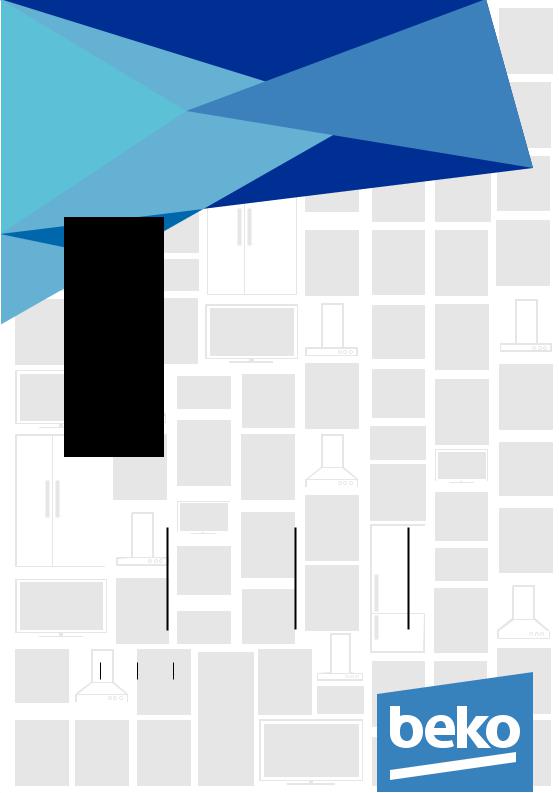
Freezer |
User Manual |
RFNE270K32W |
EN FR DE NL |
EWWERQWEW |
Please read this user manual first!
Dear Customer,
We hope that your product, which has been produced in modern plants and checked under the most meticulous quality control procedures, will provide you an effective service.
Therefore, read this entire user manual carefully before using the product and keep it as a reference. If you handover the product to someone else, give the user manual as well.
The user manual will help you use the product in a fast and safe way.
•Read the manual before installing and operating the product.
•Make sure you read the safety instructions.
•Keep the manual in an easily accessible place as you may need it later.
•Read the other documents given with the product.
Remember that this user manual is also applicable for several other models. Differences between models will be identified in the manual.
Explanation of symbols
Throughout this user manual the following symbols are used:
CImportant information or useful tips.
AWarning against dangerous conditions for life and property. BWarning against electric voltage.

CONTENTS
1 Your Freezer |
3 |
2 Important Safety Warnings4
Intended use................................................ |
4 |
General safety............................................. |
4 |
For products with a .................................. |
7 |
water dispenser;........................................ |
7 |
Child safety................................................... |
7 |
Compliance with WEEE Directive and |
|
Disposing of the Waste Product: ........ |
8 |
Package information................................. |
8 |
HC warning................................................... |
8 |
Things to be done for energy saving.8 |
|
3 Installation |
10 |
Points to be paid attention to when |
|
the relocation of the refrigerator...... |
10 |
Electrical connection.............................. |
10 |
Disposing of the packaging................. |
11 |
Disposing of your old refrigerator..... |
11 |
Placing and Installation......................... |
11 |
4 Preparation |
12 |
Adjusting the legs.................................... |
13 |
Door Open Warning................................. |
13 |
5 Using your cooler/freezer15
Setting the operating temperature.15 |
|
Fast freeze.................................................. |
17 |
Defrosting................................................... |
17 |
Freezing fresh food................................. |
18 |
Recommendations for preservation of |
|
frozen food................................................. |
18 |
Placing the food........................................ |
18 |
Deep-freeze information...................... |
19 |
6 Maintenance and |
|
cleaning |
20 |
Protection of plastic surfaces ........... |
20 |
3 EN
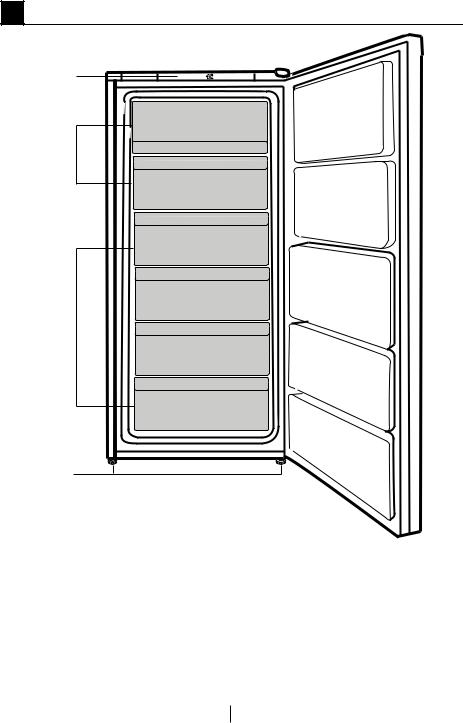
1 Your Freezer
1
2
3
4
1.Control Panel
2.Flap
3.Drawers
4.Adjustable front feet
CFigures that take place in this instruction manual are schematic and may not correspond exactly with your product. If the subject parts are not included in the product you have purchased, then it is valid for other models.
4 EN

2 Important Safety Warnings
Please review the following information. Failure to observe this information may cause injuries or material damage. Otherwise, all warranty and reliability commitments will become invalid.
Original spare parts will be provided for 10 years, following the product purchasing date.
Intended use
|
|
|
|
|
|
WARNING: |
ventilation |
||
|
Keep |
|
||
A |
openings, |
|
in |
the |
|
appliance |
enclosure |
or |
|
|
in the built-in structure, |
|||
|
clear of obstruction. |
|
||
|
WARNING: Do not use |
|||
|
mechanical devices |
|
||
|
or other means |
|
||
A |
to accelerate the |
|
||
|
defrostingprocess, |
|
||
|
other than those |
|
||
|
recommended by the |
|
||
|
manufacturer. |
|
||
|
WARNING: |
|
the |
|
A |
Do not |
damage |
||
|
refrigerant circuit. |
|
||
|
WARNING: Do not use |
|||
|
electrical appliances |
|
||
|
inside the food storage |
|||
A |
compartments of |
|
||
|
the appliance, unless |
|
||
|
they are of the type |
|
||
|
recommended by the |
|
||
|
manufacturer. |
|
||
WARNING:
Do not store explosive A substances such as aerosol cans with a flammable propellant in
this appliance.
This |
appliance is |
intended |
to be used in household and |
||
similar applications such as |
||
– staff kitchen areas in shops, |
||
offices |
and other |
working |
environments;
– farm houses and by clients in hotels, motels and other residential type environments;
– bed and breakfast type environments;
– catering and similar non-retail applications.
General safety
•When you want to dispose/ scrap the product, we recommend you to consult the authorized service in order to learn the required information and authorized bodies.
•Consult your authorized service for all your questions and problems related to the refrigerator. Do not intervene or let someone intervene
to the refrigerator without notifying the authorised services.
5 EN

•For products with a freezer compartment; Do not eat cone ice cream and ice cubes immediately after you take them out of the freezer compartment! (This may cause frostbite in your mouth.)
•For products with a freezer compartment; Do not put bottled and canned liquid beverages in the freezer compartment. Otherwise, these may burst.
•Do not touch frozen food by hand; they may stick to your hand.
•Unplug your refrigerator before cleaning or defrosting.
•Vapor and vaporized cleaning materials should never
be used in cleaning and defrosting processes of your refrigerator. In such cases, the vapor may get in contact with the electrical parts and cause short circuit or electric shock.
•Never use the parts on your refrigerator such as the door as a means of support or step.
•Do not use electrical devices inside the refrigerator.
•Do not damage the parts, where the refrigerant is circulating, with drilling or cutting tools. The refrigerant that might blow out when the gas channels of the evaporator, pipe extensions or surface coatings are punctured causes skin irritations and eye injuries.
•Do not cover or block the ventilation holes on your refrigerator with any material.
•Electrical devices must be repaired by only authorised persons. Repairs performed by incompetent persons create a risk for the user.
•In case of any failure or during a maintenance or repair work, disconnect your refrigerator’s mains supply by either turning off the relevant fuse or unplugging your appliance.
•Do not pull by the cable when pulling off the plug.
•Ensure highly alcoholic beverages are stored securely with the lid fastened and placed upright.
•Never store spray cans containing flammable and explosive substances in the refrigerator.
•Do not use mechanical devices or other means to accelerate the defrosting process, other than those recommended by the manufacturer.
•This product is not intended to be used by persons with physical, sensory or mental disorders or unlearned
or inexperienced people (including children) unless they are attended by a person who will be responsible
for their safety or who will instruct them accordingly for use of the product
6 EN
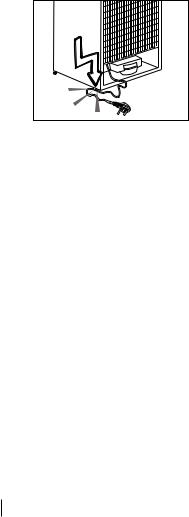
•Do not operate a damaged refrigerator. Consult with the service agent if you have any concerns.
•Electrical safety of your refrigerator shall be guaranteed only if the earth system in your house complies with standards.
•Exposing the product to rain, snow, sun and wind is dangerous with respect to electrical safety.
•Contact authorized service when there is a power cable damage to avoid danger.
•Never plug the refrigerator into the wall outlet during installation. Otherwise, risk of death or serious injury may arise.
•This refrigerator is intended for only storing food items. It must not be used for any other purpose.
•Label of technical specifications is located on the left wall inside the refrigerator.
•Never connect your refrigerator to electricitysaving systems; they may damage the refrigerator.
•If there is a blue light on the refrigerator, do not look at the blue light with optical tools.
•For manually controlled refrigerators, wait for at least 5 minutes to start the refrigerator after power failure.
•This operation manual should be handed in to the new owner of the product when it is given to others.
•Avoid causing damage on power cable when
transporting the refrigerator. Bending cable may cause fire. Never place heavy objects on power cable. Do not touch the plug with wet hands when plugging the product
•Do not plug the refrigerator if the wall outlet is loose.
•Water should not be sprayed on inner or outer parts of the product for safety purposes.
•Do not spray substances containing inflammable gases such as propane gas near the refrigerator to avoid fire and explosion risk.
•Never place containers filled with water on top of the refrigerator; in the event of spillages, this may cause electric shock or fire.
•Do not overload the refrigerator with food. If overloaded, the food items may fall down and hurt you and damage refrigerator when you open the door.
7 EN

•Never place objects on top of the refrigerator; otherwise, these objects may fall down when you open or close the refrigerator’s door.
•As they require a precise temperature, vaccines, heat-sensitive medicine and scientific materials and etc. should not be kept in the refrigerator.
•If not to be used for a long time, refrigerator should be unplugged. A possible problem in power cable may cause fire.
•Refrigerator may move if adjustable legs are not
properly secured on the floor. Properly securing adjustable legs on the floor can prevent the refrigerator to move.
•When carrying the refrigerator, do not hold it from door handle. Otherwise, it may be snapped.
•When you have to place your product next to another refrigerator or freezer, the distance between devices should be at least 8cm. Otherwise, adjacent side walls may be humidified.
•The product shall never be used while the compartment which is located at the top or back of your product and in which electronic boards are available (electronic board box cover) (1) is open.
1 |
1
For products with a water dispenser;
•Pressure for cold water inlet shall be maximum 90 psi (6.2 bar). If your water pressure exceeds 80 psi (5.5 bar), use a pressure limiting valve in your mains system. If you do not know how to check your water pressure, ask for the help of a professional plumber.
•If there is risk of water hammer effect in your installation, always use a water hammer
prevention equipment in your installation. Consult Professional plumbers is you are not sure that there is no water hammer effect in your installation.
8 EN

•Do not install on the hot water inlet. Take precautions against of the risk of freezing of the hoses. Water temperature operating interval shall be 33°F (0.6°C) minimum and 100°F (38°C) maximum.
•Use only potable water.
Child safety
•If the door has a lock, the key should be kept away from reach of children.
•Children must be supervised to prevent them from tampering with the product.
Compliance with WEEE Directive and Disposing of the Waste Product:
This product complies
with EU WEEE Directive (2012/19/EU). This product bears a classification symbol for waste electrical and electronic equipment
(WEEE).
This product has been manufactured with high quality parts and materials which can be reused and are suitable for recycling. Therefore, do not dispose the product with normal domestic waste at the end of its service life. Take it to a collection point for the recycling of electrical and electronic equipment. Please consult your local authorities to learn the nearest collection point. Help protect the environment and natural resources by recycling used products. For children’s
safety, cut the power cable and break the locking mechanism of the door, if any, so that it will be non-functional before disposing of the product.
Package information
Packaging materials of the product are manufactured from recyclable materials in accordance with our National Environment Regulations. Do not dispose of the packaging materials together with the domestic or other wastes. Take them to the packaging material collection points designated by the local authorities.
Do not forget...
Any recycled substance is an indispensable matter for nature and our national asset wealth.
If you want to contribute to the re-evaluation of the packaging materials, you can consult to your environmentalist organizations or the municipalities where you are located.
HC warning
If your product's cooling system contains R600a:
This gas is flammable. Therefore, pay attention to not damaging the cooling system and piping during usage and transportation. In the event of damage, keep your product away from potential fire sources that can cause the product catch a fire and ventilate the room in which the unit is placed.
Ignore this warning if your product's cooling system contains R134a.
Type of gas used in the product is stated in the type label which is on the left wall inside the refrigerator.
Never throw the product in fire for disposal.
9 EN

Things to be done for energy saving
•Do not leave the doors of your refrigerator open for a long time.
•Do not put hot food or drinks in your refrigerator.
•Do not overload your refrigerator so that the air circulation inside of it is not prevented.
•Do not install your refrigerator under direct sunlight or near heat emitting appliances such as ovens, dishwashers or radiators. Keep your refrigerator at least 30cm away from heat emitting sources and at least 5cm from electrical ovens.
•Pay attention to keep your food in closed containers.
•For products with a freezer compartment; You can store maximum amount of food items in the freezer when you remove the shelf or drawer of the freezer. Energy consumption value stated for your refrigerator has been determined by removing freezer
shelf or drawer and under maximum load. There is no harm to use a shelf or drawer according to the shapes and size of food to be frozen.
•Thawing frozen food in fridge compartment will both provide energy saving and preserve the food quality.
10 EN
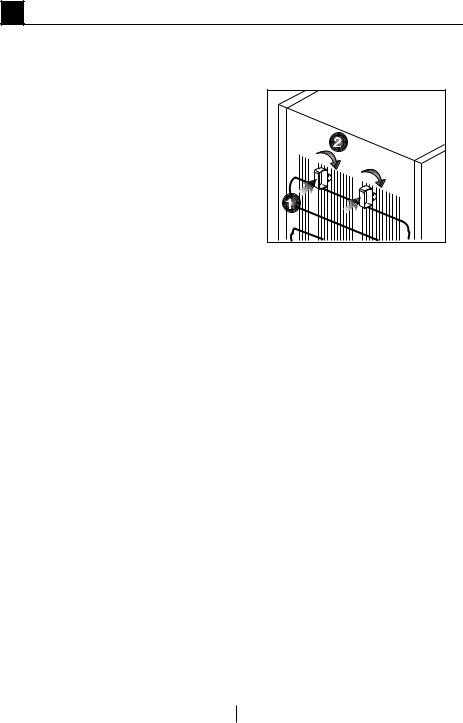
3 Installation
BIn case the information which are given in the user manual are not taken into account, manufacturer will not assume any liability for this.
Points to be paid attention to when the relocation of the refrigerator
1.Your refrigerator should be unplugged.Before transportation of your refrigerator, it should be emptied and cleaned.
2.Before it is re-packaged, shelves, accessories, crisper, etc. inside your refrigerator should be fixed with adhesive tape and secured against impacts. Package should be bound with a thick tape or sound ropes and the transportation rules on the package should be strictly observed.
3.Original packaging and foam materials should be kept for future transportations or moving.
Before you start the refrigerator,
Check the following before you start to use your refrigerator:
1.Attach 2 plastic wedges as illustrated below. Plastic wedges are intended to keep the distance which will ensure the air circulation between your refrigerator and the wall. (The picture is drawn up as a representation and it is not identical with your product.)
2.Clean the interior of the refrigerator as recommended in the “Maintenance and cleaning” section.
3. Connect the plug of the refrigerator to the wall socket. When the fridge door is opened, fridge
internal lamp will turn on.
4.When the compressor starts to operate, a sound will be heard. The liquid and gases sealed within the refrigeration system may also give rise to noise, even if the compressor is not running and this is quite normal.
5.Front edges of the refrigerator may feel warm. This is normal. These areas are designed to be warm to avoid condensation.
Electrical connection
Connect your product to a grounded socket which is being protected by a fuse with the appropriate capacity.
Important:
The connection must be in compliance with national regulations.
•The power plug must be easily accessible after installation.
•Electrical safety of your refrigerator shall be guaranteed only if the earth system in your house complies with standards.
11 EN

•The voltage stated on the label located at left inner side of your product should be equal to your network voltage.
•Extension cables and multi plugs must not be used for connection.
BA damaged power cable must be replaced by a qualified electrician.
BProduct must not be operated before it is repaired! There is the risk of electric shock!
Disposing of the packaging
The packing materials may be dangerous for children. Keep the packing materials out of the reach of children or dispose of them by classifying them in accordance with the waste instructions stated by your local authorities. Do not throw away with regular house waste, throw away on packaging pick up spots designated by the local authorities.
The packing of your refrigerator is produced from recyclable materials.
Disposing of your old refrigerator
Dispose of your old refrigerator without giving any harm to the environment.
•You may consult your authorized dealer or waste collection center of your municipality about the disposal of your refrigerator.
Before disposing of your refrigerator, cut out the electric plug and, if there are any locks on the door, make them inoperable in order to protect children against any danger.
Placing and Installation
A If the entrance door of the room where the refrigerator will be installed is not wide enough for the refrigerator to pass through, then call the authorized service to have them remove the doors of your refrigerator and pass it sideways through the door.
1.Install your refrigerator to a place that allows ease of use.
2.Keep your refrigerator away from heat sources, humid places and direct sunlight.
3.There must be appropriate air ventilation around your refrigerator in order to achieve an efficient operation. If the refrigerator is to be placed in a recess in the wall, there must be at least 5 cm distance with the ceiling and at least 5 cm with the wall. Do not place your product on the materials such as rug or carpet.
4.Place your refrigerator on an even floor surface to prevent jolts.
12 EN

4 Preparation
•Your refrigerator should be installed at least 30 cm away from heat sources such as hobs, ovens, central heater and stoves and at least 5 cm away from electrical ovens and should not be located under direct sunlight.
•It ‘s recommended to place iceacumulator directly on the food at the top compartment for energy saving.
•Please make sure that the interior of your refrigerator is cleaned thoroughly.
•If two refrigerators are to be installed side by side, there should be at least 2 cm distance between them.
•When you operate your refrigerator for the first time, please observe the following instructions during the initial six hours.
•The door should not be opened frequently.
•It must be operated empty without any food in it.
•Do not unplug your refrigerator. If a power failure occurs out of your control, please see the warnings in the “Recommended solutions for the problems” section.
•Original packaging and foam materials should be kept for future transportations or moving.
•This appliance is designed to operate at temperatures specified in the table below is equipped with Advanced Electronic Temperature Control System [AETCS] which ensures that at the advised setting [4 - four on the knob] the frozen food in the freezer will not defrost even if the ambient temperature falls as low as -15 °C. When first installed the product MUST NOT be placed in low ambient temperatures because the freezer will not reduce to it’s standard operating temperature. Once it has reached its steady operating state it can be re-located. So you may then install your appliance in a garage or an unheated room without having
to worry about frozen food in the freezer being spoilt. However at low ambient temperatures mentioned above, fridge contents are likely to freeze, so check and consume food in the fridge accordingly. When the ambient temperature returns to normal, you may change the knob setting to suit your needs.
•If the ambient temperature is below 0°C, the food in the fridge compartment will freeze.So, we recommend you don’t use the fridge compartment in such low ambient conditions. You can continue using the freezer compartment as usual.
13 EN
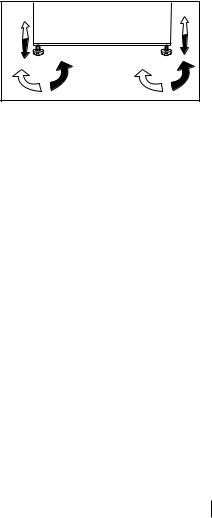
Adjusting the legs
If your refrigerator is unbalanced; You can balance your refrigerator
by turning its front legs as illustrated in the figure. The corner where the leg exists is lowered when you turn in the direction of black arrow and raised when you turn in the opposite direction. Taking help from someone to slightly lift the refrigerator will facilitate this process.
Door Open Warning
*May not be available in all models
An audio warning signal will be given when the door of your product is left open for at least 1 minute. This warning will be muted when the door is closed or any of the display buttons (if any) are pressed.
14 EN
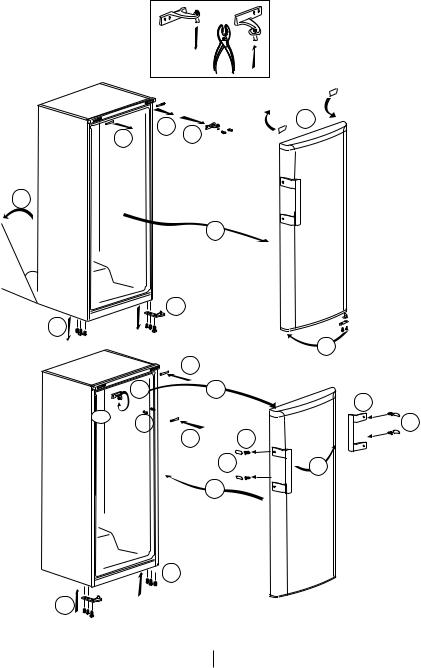
Reversing the doors
Proceed in numerical order .
(12)
|
2 |
5 |
|
1 |
3 |
||
|
6
4
45¡
|
8 |
|
|
7 |
|
|
|
|
|
|
9 |
|
16 |
|
|
|
12 |
13 |
20 |
180¡ |
|
|
|
15 |
|
21 |
|
|
16 |
|
18 |
|
|
17 |
19 |
|
|
14 |
|
11
10
15 EN
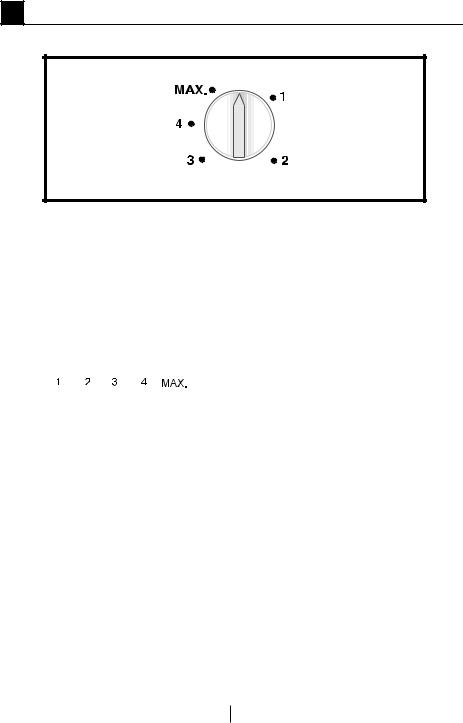
5 Using your refrigerator
Setting the operating temperature
The operating temperature is regulated by the temperature control.
1 = Lowest cooling setting (Warmest setting)
MAX. = Highest cooling setting (Coldest setting))
Please choose the setting which
Warm





 Cold
Cold
is consistant with the desired temperature.
The interior temperature also depends on ambient temperature, the frequency with which the door is opened and the amount of foods kept inside.
Frequently opening the door causes the interior temperature to rise.
For this reason, it is recommended to close the door as soon as possible after use.
The normal storage temperature of your appliance should be -18 °C (0 °F). Lower temperatures can be obtained by adjusting the thermostat control towards the position MAX.
We recommend checking the temperature with a thermometer to ensure that the storage compartments are kept to the desired temperature. Remember to read off the thermometer immediately as the temperature on the thermometer will rise very rapidly after you remove it from the freezer.
AAttention
Do not exceed the freezing capacity of your appliance in 24 hours. See the rating label.
In order to maintain the quality of the food, the freezing must take effect as quickly as possible. In this way, the freezing capacity will not be exceeded, and the temperature inside the freezer will not rise.
16 EN

AAttention
Always keep the already deep-frozen food separated from freshly placed food.
If you find the freezer door difficult to open just after you have closed it, don’t worry. This is due to the pressure difference which will equalize and allow the door to open normally after a few minutes.
You will hear a vacuum sound just after closing the door. This is quite normal.
Door Open Warning
*May not be available in all models
An audio warning signal will be given when the door of your product is left open for at least 1 minute. This warning will be muted when the door is closed or any of the display buttons (if any) are pressed.
Fast freeze
If large amounts of fresh food are going to be frozen, adjust the thermostat control to the MAX. position. 24 hours before putting the fresh food in the fast freeze compartment.
It is strongly recommended to keep the thermostat control at the MAX. position for at least 24 hours to freeze the maximum amount of fresh food stated as the freezing capacity. Take special care not to mix frozen and fresh food.
Defrosting the appliance
The appliance defrosts automatically.
17 EN

Freezing fresh food
•It must be preferred to wrap or cover the food before placing them in the refrigerator.
•Hot food must cool down to the room temperature before putting them in the refrigerator.
•The foodstuff that you want to freeze must be fresh and in good quality.
•Foodstuff must be divided into portions according to the family’s daily or meal based consumption needs.
•The foodstuff must be packaged in an airtight manner to prevent them from drying even if they are going to be kept for a short time.
•Materials to be used for packaging must be tear-proof and resistant to cold, humidity, odor, oils and acids and they must also be airtight. Moreover, they must be well closed and they must be made from easy- to-use materials that are suitable for deep freeze usage.
•Frozen food must be used immediately after they are thawed and they should never be re-frozen.
•Please observe the following instructions to obtain the best results.
1.Do not freeze too large quantities of food at one time. The quality of the food is best preserved when it is frozen right through to the core as quickly as possible.
2.Placing warm food into the freezer compartment causes the cooling system to operate
continuously until the food is frozen solid.
3.Take special care not to mix already frozen food and fresh food.
Recommendations for preservation of frozen food
•Prepacked commercially frozen food should be stored in accordance with the frozen food manufacturer's instructions for a  ( 4 star) frozen food storage compartment.
( 4 star) frozen food storage compartment.
•To ensure that the high quality achieved by the frozen food manufacturer and the food retailer is maintained, the following should be remembered:
1.Put packages in the freezer as quickly as possible after purchase.
2.Ensure that contents are labeled and dated.
3.Do not exceed "Use By", "Best Before" dates on the packaging.
Defrosting
The freezer compartment defrosts automatically.
18 EN

Placing the food
Freezer compartment |
Various frozen food such |
|
as meat, fish, ice cream, |
||
shelves |
||
vegetables and etc. |
||
|
||
|
|
|
Egg tray |
Egg |
|
|
|
|
Fridge compartment |
Food in pans, covered |
|
plates and closed |
||
shelves |
||
containers |
||
|
||
|
|
|
Fridge compartment |
Small and packaged food |
|
or drinks (such as milk, fruit |
||
door shelves |
||
juice and beer) |
||
|
||
|
|
|
Crisper |
Vegetables and fruits |
|
|
|
|
Freshzone |
Delicatessen products |
|
(cheese, butter, salami |
||
compartment |
||
and etc.) |
||
|
||
|
|
Deep-freeze information
Food must be frozen as rapidly as possible when they are put in a refrigerator in order to keep them in good quality.
It is possible to keep the food for a long time only at -18°C or lower temperatures.
You can keep the freshness of food for many months (at -18°C or lower temperatures in the deep freeze).
WARNING! A
•Foodstuff must be divided into portions according to the family’s daily or meal based consumption needs.
•Foodstuff must be packaged in an airtight manner to prevent them from drying even if they are going to be kept for a short time.
•Materials necessary for packaging:
•Cold resistant adhesive tape
•Self adhesive label
•Rubber rings
•Pen
Materials to be used for packaging the foodstuff must be tear-proof and resistant to cold, humidity, odor, oils and acids.
Foodstuff to be frozen should not be allowed to come in contact with the previously frozen items to prevent their partial thawing.
19 EN

6 Maintenance and cleaning
ANever use gasoline, benzene or similar substances for cleaning purposes.
BWe recommend that you unplug the appliance before cleaning.
BNever use any sharp abrasive instrument, soap, household cleaner, detergent and wax polish for cleaning.
BFor non-No Frost products, water drops and frosting up to a
fingerbreadth occur on the rear wall of the Fridge compartment. Do not clean it; never apply oil or similar agents on it.
BOnly use slightly damp microfiber cloths to clean the outer surface of the product. Sponges and other
types of cleaning cloths may scratch the surface.
CUse lukewarm water to clean the cabinet of your refrigerator and wipe it dry.
CUse a damp cloth wrung out in a solution of one teaspoon of
bicarbonate of soda to one pint of water to clean the interior and wipe it dry.
BMake sure that no water enters the lamp housing and other electrical items.
BIf your refrigerator is not going to be used for a long period of time, unplug the power cable, remove all food, clean it and leave the door ajar.
CCheck door seals regularly to ensure they are clean and free from food particles.
ATo remove door racks, remove all the contents and then simply push the door rack upwards from the base.
ANever use cleaning agents or water that contain chlorine to clean the outer surfaces and chromium coated parts of the product. Chlorine causes corrosion on such metal surfaces.
ADo not use sharp, abrasive tools, soap, household cleaning agents, detergents, kerosene, fuel oil, varnish etc. to prevent removal and deformation of the prints on the plastic part. Use lukewarm water and a soft cloth for cleaning and then wipe it dry.
Protection of plastic surfaces
CDo not put the liquid oils or oilcooked meals in your refrigerator in unsealed containers as they damage the plastic surfaces of your refrigerator. In case of spilling or smearing oil on the plastic surfaces, clean and rinse the relevant part
of the surface at once with warm water.
20 EN
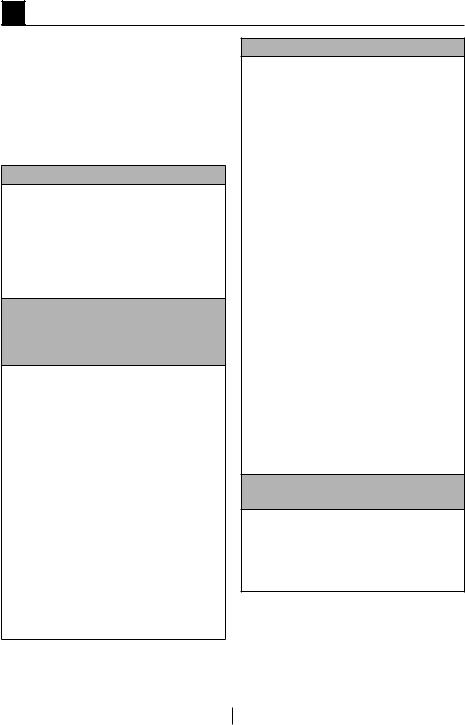
7 Troubleshooting
Please review this list before calling the service. It will save your time and money. This list includes frequent complaints that are not arising
from defective workmanship or material usage. Some of the features described here may not exist in your product.
The refrigerator does not operate.
•The plug is not inserted into the socket correctly. >>>Insert the plug into the socket securely.
•The fuse of the socket which your refrigerator is connected to or the main fuse have blown out.
>>>Check the fuse.
Condensation on the side wall of the fridge compartment (MULTIZONE, COOL CONTROL and FLEXI ZONE).
•Door has been opened frequently. >>>Do not open and close the door of refrigerator frequently.
•Ambient is very humid. >>>Do
not install your refrigerator into highly humid places.
•Food containing liquid is stored in open containers. >>>Do not store food with liquid content in open containers.
•Door of the refrigerator is left ajar. >>>Close the door of the refrigerator.
•Thermostat is set to a very cold level. >>>Set the thermostat to a suitable level.
Compressor is not running
•Protective thermic of the compressor will blow out during sudden power failures or plugout plug-ins as the refrigerant pressure in the cooling system of the refrigerator has not been
balanced yet. The refrigerator will start running approximately after 6 minutes. Please call the service if the refrigerator does not startup at the end of this period.
•The fridge is in defrost cycle.
>>>This is normal for a fullautomatically defrosting refrigerator. Defrosting cycle occurs periodically.
•The refrigerator is not plugged into the socket. >>>Make sure that the plug is fit into the socket.
•Temperature settings are not made correctly. >>>Select the suitable temperature value.
•There is a power outage.
>>>Refrigerator returns to normal operation when the power restores.
The operation noise increases when the refrigerator is running.
•The operating performance of the refrigerator may change due to the changes in the ambient temperature. It is normal and not a fault.
21 EN

The refrigerator is running frequently or for a long time.
•New product may be wider than the previous one. Larger
refrigerators operate for a longer period of time.
•The room temperature may be high. >>>It is normal that the product operates for longer periods in hot ambient.
•The refrigerator might be plugged in recently or might be loaded with food. >>>When
the refrigerator is plugged in or loaded with food recently, it will take longer for it to attain the set temperature. This is normal.
•Large amounts of hot food might be put in the refrigerator recently.
>>>Do not put hot food into the refrigerator.
•Doors might be opened frequently or left ajar for a long time. >>>The warm air that has entered into the refrigerator causes the refrigerator to run for longer periods. Do not open the doors frequently.
•Freezer or fridge compartment door might be left ajar.
>>>Check if the doors are closed completely.
•The refrigerator is adjusted to a very low temperature. >>>Adjust
the refrigerator temperature to a warmer degree and wait until the temperature is achieved.
•Door seal of the fridge or freezer may be soiled, worn out, broken or not properly seated. >>>Clean or replace the seal. Damaged/broken seal causes the refrigerator to run for a longer period of time in
order to maintain the current 22 temperature.
Freezer temperature is very low while the fridge temperature is sufficient.
•The freezer temperature is adjusted to a very low value.
>>>Adjust the freezer temperature to a warmer degree and check.
Fridge temperature is very low while the freezer temperature is sufficient.
•The fridge temperature is adjusted to a very low
value. >>>Adjust the fridge temperature to a warmer degree and check.
Food kept in the fridge compartment drawers is frozen.
•The fridge temperature is adjusted to a very high
value. >>>Adjust the fridge temperature to a lower value and check.
EN

Temperature in the fridge or freezer is very high.
•The fridge temperature is adjusted to a very high value.
>>>Fridge compartment temperature setting has an effect on the temperature of the freezer. Change the temperatures of the fridge or freezer and wait until the relevant compartments attain a sufficient temperature.
•Doors are opened frequently or left ajar for a long time. >>>Do
not open the doors frequently.
•Door is ajar. >>>Close the door completely.
•The refrigerator is plugged in or loaded with food recently.
>>>This is normal. When the refrigerator is plugged in or loaded with food recently, it will take longer for it to attain the set temperature.
•Large amounts of hot food might be put in the refrigerator recently.
>>>Do not put hot food into the refrigerator.
Vibrations or noise.
•The floor is not level or stable.
>>> If the refrigerator rocks when moved slowly, balance it by adjusting its feet. Also make sure that the floor is strong enough to carry the refrigerator, and level.
•The items put onto the refrigerator may cause noise.
>>>Remove the items on top of the refrigerator.
There are noises coming from the refrigerator like liquid flowing, spraying, etc.
•Liquid and gas flows occur in accordance with the operating principles of your refrigerator. It is normal and not a fault.
Whistle comes from the refrigerator.
•Fans are used in order to cool the refrigerator. It is normal and not a fault.
Condensation on the inner walls of refrigerator.
•Hot and humid weather increases icing and condensation. It is normal and not a fault.
•Doors are opened frequently or left ajar for a long time. >>>Do
not open the doors frequently. Close them if they are open.
•Door is ajar. >>>Close the door completely.
Humidity occurs on the outside of the refrigerator or between the doors.
•There might be humidity in the air; this is quite normal in humid weather. When the humidity is less, condensation will disappear.
23 EN

Bad odour inside the refrigerator.
•No regular cleaning is performed.
>>>Clean the inside of the refrigerator regularly with a sponge, lukewarm water or carbonate dissolved in water.
•Some containers or package materials may cause the smell.
>>>Use a different container or different brand packaging material.
•Food is put into the refrigerator in uncovered containers. >>>Keep
the food in closed containers. Microorganisms spreading out from uncovered containers can cause unpleasant odours.
•Remove the foods that have expired best before dates and spoiled from the refrigerator.
The door is not closing.
•Food packages are preventing the door from closing.
>>>Replace the packages that are obstructing the door.
•The refrigerator is not completely even on the floor. >>>Adjust the feet to balance the refrigerator.
•The floor is not level or strong.
>>>Make sure that the floor is level and capable to carry the refrigerator.
Crispers are stuck.
•The food is touching the ceiling of the drawer. >>>Rearrange
food in the drawer.
If The Surface Of The Product Is
Hot.
•High temperatures may be observed between the two doors, on the side panels and at the rear grill while the product is operating. This is normal
and does not require service maintenance!
24 EN
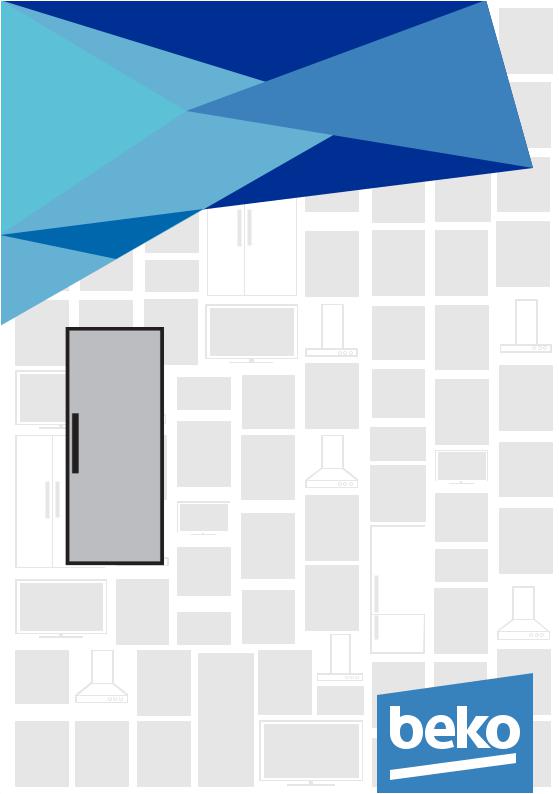
Congélateur |
Manuel d'utilisation |
FR |
Veuillez commencer par lire ce manuel d’utilisation!
Cher client,
Nous espérons que votre produit, qui a été fabriqué dans des usines modernes et vérifié au terme des procédures de contrôle de qualité les plus méticuleuses, vous donnera entière satisfaction.
Veuillez donc lire attentivement l'intégralité de ce manuel avant de commencer à utiliser le produit et conservez-le manuel comme référence. Si vous remettez cet appareil à quelqu'un d'autre, remettez-lui également le manuel d'utilisation.
Ce manuel vous aidera à utiliser votre produit ent toute sécurité et efficacement.
•Lisez le manuel avant d’installer et de faire fonctionner votre produit.
•Veillez à lire les instructions de sécurité.
•Laissez ce manuel dans un endroit facile d’accès car vous pourriez en avoir besoin ultérieurement.
•Lisez également la documentation fournie avec le produit.
N'oubliez pas que le manuel d'utilisation est également valable pour plusieurs autres modèles. Les différences entre les différents modèles seront identifiées dans le manuel.
Explication des symboles
Les symboles ci-dessous sont utilisés dans le manuel d'utilisation:
C Informations importantes ou astuces.
AAvertissement relatif aux situations dangereuses pour la vie et la propriété.
BAvertissement relatif à la tension électrique.

TABLE DES MATIÈRES
1 Votre congélateur |
4 |
2 Précautions de sécurité |
|
importantes |
5 |
Utilisation préconisée.............................. |
5 |
Sécurité générale...................................... |
5 |
Pour les appareils dotés d'une |
|
fontaine à eau........................................... |
11 |
Sécurité enfants....................................... |
11 |
Conformité avec la règlementation |
|
DEEE et mise au rebut des déchets.12 |
|
Informations relatives à l'emballage.12 |
|
Avertissement HC.................................... |
12 |
Mesures d’économie d’énergie........... |
13 |
3 Installation |
14 |
Éléments à prendre en considération |
|
lors du déplacement de votre |
|
congélateur................................................ |
14 |
Avant de mettre votre congélateur en |
|
marche.......................................................... |
14 |
Branchement électrique....................... |
15 |
Mise au rebut de l’emballage............... |
15 |
Mise au rebut de votre ancien |
|
congélateur................................................ |
15 |
Disposition et Installation.................... |
16 |
Réglage des pieds.................................... |
16 |
4 Préparation |
17 |
Réversibilité des portes......................... |
19 |
5 Utilisation du |
|
congélateur |
20 |
Réglage de la température de |
|
fonctionnement...................................... |
20 |
Congélation................................................ |
21 |
Alarme porte ouverte............................ |
22 |
Système de réfrigération NeoFrost :23.
Congélation des produits frais.......... |
23 |
Recommandations concernant la conservation des aliments congelés23.
Disposition des aliments...................... |
24 |
Informations concernant la |
|
congélation................................................ |
24 |
6 Entretien et nettoyage |
26 |
Protection des surfaces en |
|
plastique. ................................................... |
26 |
7 Dépannage |
27 |
3 FR
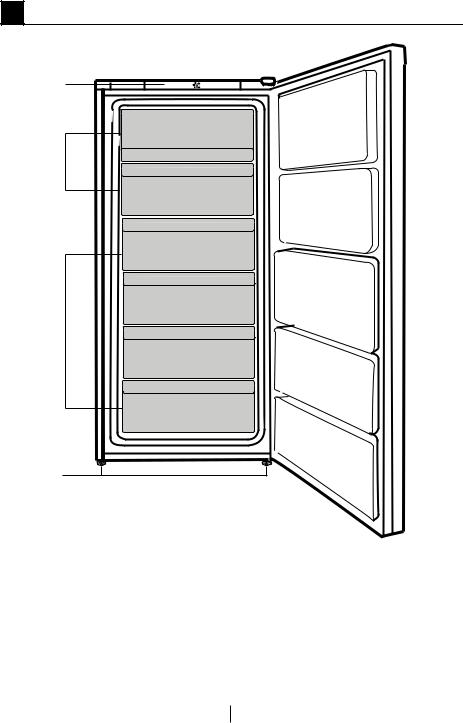
1 Votre congélateur
1
2
3
4
1.Ventilateur
2.Déflecteur (compartiment Congélation Rapide)
3.Tiroirs
4.Pieds avant réglables
CLes illustrations présentées dans cette notice d’utilisation sont schématiques et peuvent ne pas correspondre exactement à votre produit. Si des pièces présentées ne sont pas comprises dans le produit que vous avez acheté, elles
sont valables pour d’autres modèles.
4 FR

2 Précautions de sécurité importantes
Veuillez |
|
examiner |
les |
Les pièces |
détachées |
|||||||
informations suivantes : |
d’origine sont disponibles |
|||||||||||
Cet appareil |
peut |
être |
pendant 10 |
ans, à |
||||||||
utilisé par |
|
des |
enfants |
compterdeladated’achat |
||||||||
âgés d’au moins 8 ans |
||||||||||||
et |
par |
des personnes |
du produit. |
|
||||||||
ayant |
des |
|
capacités |
Utilisation |
|
|||||||
physiques, |
|
|
sensorielles |
préconisée |
|
|||||||
ou mentales réduites ou |
Ce produit est prévu |
|||||||||||
dénuées d’expérience ou |
pour une utilisation |
|||||||||||
de connaissance, s’ils (si |
• en intérieur et dans des |
|||||||||||
elles) sont correctement |
zones fermées telles |
|||||||||||
surveillé(e)s |
|
ou |
si |
des |
que les maisons ; |
|||||||
instructions |
|
relatives à |
• dans les |
|
||||||||
l’utilisation |
|
de |
l’appareil |
|
||||||||
en |
toute |
|
sécurité |
leur |
environnements de |
|||||||
|
travail fermées, tels |
|||||||||||
ont |
été |
données et si |
||||||||||
que les magasins et les |
||||||||||||
les risques encourus ont |
||||||||||||
bureaux ; |
|
|||||||||||
été |
appréhendées. |
Les |
|
|||||||||
• dans les lieux |
||||||||||||
enfants |
ne |
|
doivent pas |
|||||||||
jouer avec |
|
l’appareil. Le |
d'hébergement fermés, |
|||||||||
nettoyage et l’e |
l’usager |
tels que les fermes, |
||||||||||
ntretien |
|
par |
|
hôtels, pensions. |
||||||||
ne |
doivent |
|
pas |
être |
• Il ne doit pas être utilisé |
|||||||
effectués par des enfants |
en extérieur. |
|
||||||||||
sans surveillance. |
|
de |
Sécurité générale |
|||||||||
Le |
non |
|
|
respect |
||||||||
ces |
consignes |
|
peut |
• Si le cordon |
|
|||||||
entraîner |
des |
blessures |
d’alimentation est |
|||||||||
ou dommages matériels. |
endommagé, celui-ci |
|||||||||||
Sinon, tout engagement |
doit être remplacé par |
|||||||||||
lié |
à la |
|
garantie |
et à |
le fabricant, ses agents |
|||||||
la |
fiabilité |
|
|
du |
produit |
agréés ou tout autre |
||||||
devient invalide. |
|
5 |
agent qualifié afin d’être |
|||||||||
|
|
|
|
|
|
|
|
|
FR à l’abri de tout danger. |
|||

•Avant de vous débarrasser de votre appareil, veuillez consulter les autorités locales ou votre revendeur pour connaître le mode opératoire et les organismes de collecte agréés.
•Consultez le service après-vente agréé concernant toutes questions ou problèmes relatifs au congélateur. N’intervenez pas ou
ne laissez personne intervenir sur le congélateur sans le communiquer au service après-vente agréé.
•Pour les produits équipés d'un compartiment congélateur : ne mangez pas de cônes de crème glacée ou des glaçons immédiatement après les avoir sortis
du compartiment de congélation ! (Cela pourrait provoquer des engelures dans votre bouche).
6
•Pour les produits équipés d'un compartiment congélateur : ne placez pas de boissons en bouteille ou en cannette dans le compartiment de congélation. Cela peut entraîner leur éclatement.
•Ne touchez pas des produits congelés avec les mains, ils pourraient se coller à celles-ci.
•Débranchez votre congélateur avant de le nettoyer ou de le dégivrer.
•La vapeur et des matériaux de nettoyage pulvérisés ne doivent jamais être utilisés pour les processus
de nettoyage ou de dégivrage de votre congélateur. La vapeur pourrait pénétrer dans les pièces électriques et provoquer des courts-circuits ou des électrocutions.
•Ne jamais utiliser les pièces de votre
congélateur telles que la porte, comme un
support ou une marche.FR
